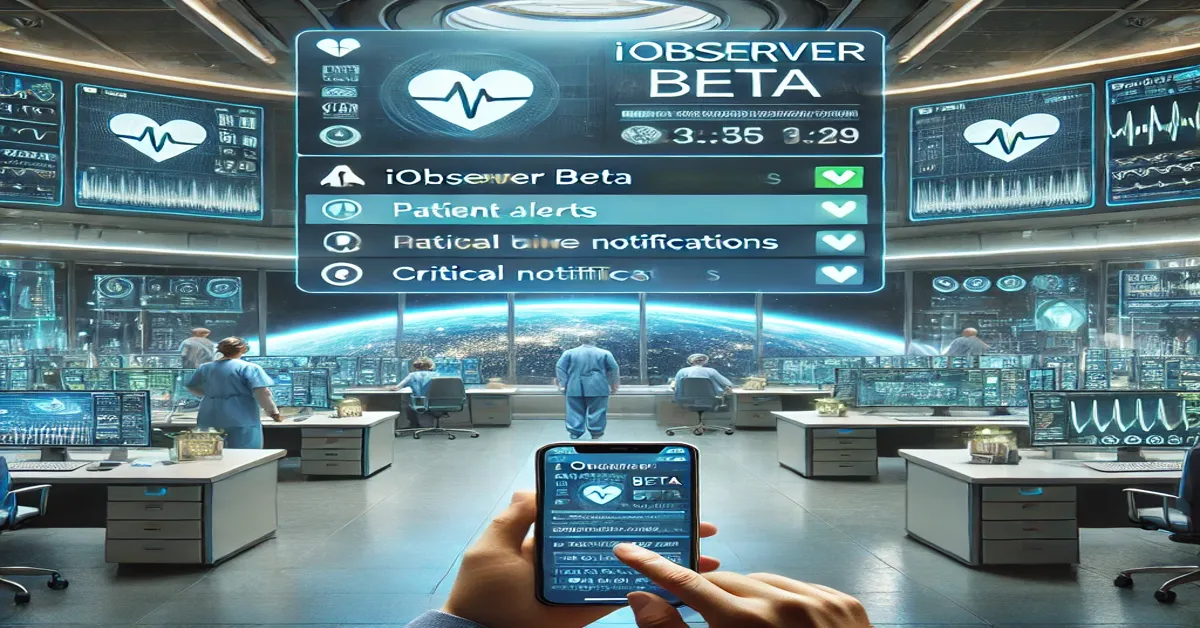The healthcare industry is continually evolving, with technology playing a crucial role in improving patient care, reducing errors, and enhancing communication. Among the emerging tools designed to enhance these aspects is iObserver Beta, a solution offered by Caregility Net. This system integrates various healthcare notifications and alert mechanisms that are critical for monitoring patient conditions in real-time, ensuring that healthcare professionals are equipped with the information they need at the right time. In iobserverbeta.caregility net notifications article, we will dive deep into how iObserver Beta works, its benefits, and its impact on patient care.
1. What is iObserver Beta?
iobserverbeta.caregility net notifications is a remote monitoring platform developed by Caregility Net, a company known for its cutting-edge healthcare technology solutions. The system is designed to provide real-time, continuous patient observation, which is particularly critical in intensive care units (ICUs), emergency rooms, and other high-acuity areas. The iObserver Beta system is powered by advanced sensors, cameras, and monitoring tools that give healthcare providers a constant view of patient conditions.
The notification feature of iObserver Beta is one of its most important components, allowing medical staff to receive timely alerts based on predefined patient conditions or status changes. These notifications help ensure that healthcare providers can react quickly to evolving patient needs, improving patient safety and care outcomes.
2. The Role of Notifications in iObserver Beta
Notifications play a pivotal role in the iObserver Beta system, acting as the communication bridge between patient monitoring devices and healthcare professionals. The system collects data from monitoring tools, analyzes it in real time, and generates alerts based on specific thresholds. These notifications ensure that no critical information is missed, enabling timely interventions when necessary.
Notifications are typically sent to the healthcare provider’s preferred device, whether it’s a mobile phone, tablet, or workstation, ensuring instant access to information regardless of location. This feature is particularly beneficial in busy hospital environments where nurses and doctors are often multitasking.
3. Key Features of iObserver Beta Notifications
3.1 Real-Time Alerts
One of the standout features of iObserver Beta is its ability to deliver real-time alerts. These alerts are triggered based on various monitoring parameters, such as heart rate, blood pressure, oxygen levels, and more. As soon as the system detects any abnormality, it sends an immediate notification to designated healthcare staff, enabling prompt intervention.
3.2 Customization Options
The flexibility of iobserverbeta.caregility net notifications allows healthcare providers to customize notifications according to their needs. Users can set specific thresholds for different patients based on their conditions. For instance, the alert settings for a patient in the ICU may differ from those in a general ward, allowing tailored monitoring to suit individual cases.
3.3 Integration with Other Healthcare Systems
iobserverbeta.caregility net notifications is designed to integrate seamlessly with other healthcare information systems, including Electronic Health Records (EHRs), allowing all patient data to be centralized and easily accessible. Notifications from iObserver can be synced with EHRs to automatically log any significant events, ensuring accurate record-keeping and compliance with healthcare standards.
4. Benefits of iObserver Beta for Healthcare Providers
4.1 Enhanced Patient Monitoring
iobserverbeta.caregility net notifications enhances patient monitoring by providing continuous observation without requiring constant physical presence. This is particularly helpful in settings where staffing might be limited. The system offers 24/7 oversight, ensuring that patients receive timely care when it matters most.
4.2 Improved Response Times
With real-time notifications, iObserver Beta significantly improves response times. Healthcare staff no longer need to manually check patient monitors or be in the same room to be aware of changes. Notifications ensure that staff are informed of critical changes in patient status, which can make the difference between life and death in emergency situations.
4.3 Error Reduction and Compliance
Another significant benefit is the reduction of human error. Automated notifications help minimize the chances of overlooking critical changes in patient status. Furthermore, the integration of iObserver Beta with EHR systems ensures that all alerts are logged and traceable, supporting compliance with regulatory standards and providing a complete audit trail for healthcare providers.
5. Understanding Notification Types in iObserver Beta
5.1 Critical Alerts
Critical alerts are the highest-priority notifications and are triggered by life-threatening changes in a patient’s condition, such as a drastic drop in oxygen levels or heart failure. These alerts demand immediate attention and action from healthcare staff.
5.2 Routine Notifications
Routine notifications include updates on non-emergency patient status changes. These alerts are typically used for monitoring less urgent conditions but still play an important role in patient care management, allowing staff to adjust treatments as necessary.
5.3 Administrative Alerts
In addition to patient-related alerts, iObserver Beta also generates administrative notifications. These might include alerts about system maintenance, software updates, or device malfunctions. While not related to patient care, these notifications help ensure the system remains operational and secure.
6. How to Set Up and Manage Notifications in iObserver Beta
Setting up and managing notifications in iObserver Beta is designed to be user-friendly. Administrators can configure notification settings based on patient needs, room type, or even the healthcare professional’s role. The system provides an intuitive dashboard where users can easily set parameters for alert thresholds, choose the type of device to receive notifications, and even customize the tone or method of notification delivery.
Users can also prioritize different types of alerts to ensure the most critical notifications are given prominence, while less urgent ones can be managed accordingly. The system allows for adjustments to be made in real time, ensuring that alert settings can evolve with patient needs.
7. Best Practices for Utilizing iObserver Beta Notifications
To maximize the efficiency of iobserverbeta.caregility net notifications, healthcare providers should adhere to several best practices:
- Regularly review and update alert thresholds: Ensure that notification settings align with each patient’s evolving condition.
- Ensure integration with EHR systems: Syncing notifications with patient records can streamline workflows and improve care documentation.
- Train staff on notification prioritization: Staff should be trained to respond appropriately to different types of alerts, ensuring critical issues are addressed immediately.
8. The Impact of iObserver Beta Notifications on Patient Outcomes
iObserver Beta.caregility net notifications has proven to have a significant impact on patient outcomes. By reducing response times and improving the accuracy of monitoring, patients receive faster interventions during critical moments. Studies have shown that real-time notifications can reduce the rate of adverse events and improve overall patient satisfaction in healthcare settings.
Moreover, the ability to monitor patients remotely and continuously has opened up new possibilities for telehealth and remote patient care, allowing healthcare facilities to extend their reach and reduce strain on in-hospital resources.
9. Challenges and Limitations of iObserver Beta Notifications
While iObserver beta.caregility net notifications offers numerous advantages, it is not without challenges. Some of the limitations include:
- Notification overload: If not properly managed, healthcare providers may experience alert fatigue, where the high volume of notifications reduces their responsiveness to critical alerts.
- Dependence on stable internet connections: Since the system is based on real-time data transmission, any network disruptions can delay alerts, potentially compromising patient care.
- Initial setup and training: Healthcare staff need to be adequately trained on how to configure and respond to notifications, which may require an upfront investment in time and resources.
10. The Future of iObserver Beta and Notifications in Healthcare
The future of iObserver Beta looks promising, with potential advancements in artificial intelligence (AI) and machine learning (ML) to further enhance its capabilities. Future versions of the system could include predictive analytics that anticipates patient issues before they arise, offering even more proactive care.
Additionally, as telemedicine continues to grow, iObserver Beta is well-positioned to play a key role in remote patient care, allowing for even greater integration with home monitoring devices and mobile healthcare solutions.
Conclusion
In conclusion, iObserver Beta by Caregility Net revolutionizes patient care through its robust notification system, offering real-time alerts that significantly improve response times and patient outcomes. By integrating seamlessly with healthcare systems and allowing for customizable settings, it ensures that healthcare professionals are always informed about critical changes in patient status, regardless of location. The flexibility and precision of its notifications not only enhance patient monitoring but also reduce the likelihood of errors, leading to improved compliance with healthcare standards.
While there are challenges, such as notification overload and the need for stable internet connections, the benefits of iObserver Beta far outweigh these limitations. As healthcare technology continues to advance, the system’s potential for growth, especially in predictive analytics and telemedicine, positions it as a vital tool for the future of patient care, ensuring that healthcare providers are equipped to meet the demands of modern medicine.
Read: Understanding 8002: A Comprehensive Guide
11. Frequently Asked Questions (FAQs)
1. What is iObserver Beta used for?
iObserver Beta is a remote patient monitoring system designed to provide continuous observation of patients in healthcare settings, primarily to enhance safety and response times.
2. Can iObserver Beta integrate with existing healthcare systems?
Yes, iObserver Beta integrates seamlessly with Electronic Health Records (EHRs) and other healthcare systems, providing a centralized platform for patient data and notifications.
3. How are notifications delivered in iObserver Beta?
Notifications are delivered in real time via various devices such as smartphones, tablets, or workstations, ensuring healthcare professionals receive timely updates.
4. Can notifications be customized in iObserver Beta?
Yes, iObserver Beta allows healthcare professionals to customize notification settings based on patient needs and conditions, ensuring relevant alerts are prioritized.
5. What are the main types of notifications in iObserver Beta?
The main types of notifications include critical alerts, routine updates, and administrative notifications, each serving different functions within patient care management.
6. How does iObserver Beta help improve patient outcomes?
By delivering real-time alerts and ensuring continuous monitoring, iObserver Beta helps healthcare providers respond to patient needs faster, reducing the risk of adverse events and improving overall care quality.











